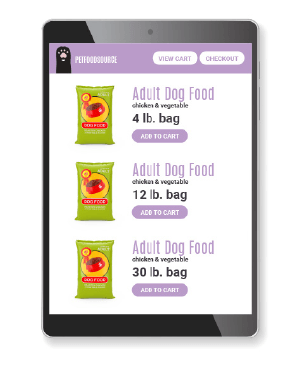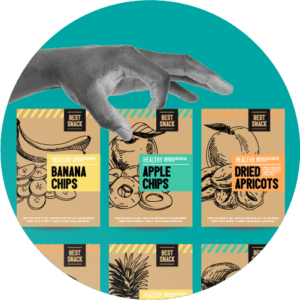Overview
We live in dramatically changing times, and nowhere is feeling the seismic forces of change more than retail.
The evolution of technology and the global pandemic has changed consumer demands and behavior. Convenience, safety, time-efficiency and evolving demographics drive demand for E-Commerce. Of course, E-commerce was growing pre-pandemic, but the latest data from IBM’s Retail Report suggests the pandemic accelerated E-Commerce penetration by five years in just five months.
This dramatic shift has huge implications for brand manufacturers who have, until now, focused their merchandising efforts on their biggest sales channel – brick-and-mortar retail.
Now however, with up to 60% of consumers planning to continue their new online shopping habits post pandemic, the center of gravity has shifted permanently.
In this new digital world, brand manufacturers must ensure their products are correctly presented not only in-store but across all E-Commerce platforms…but this is easier said than done.
The pressure for industry leaders to expand digital presence and increase in-house expertise can feel impossible to accomplish.
E-Commerce represents a significant source of current and future growth for the Consumer Packaged Goods industry.
Despite significant improvements, the CPG industry is still behind well established online categories such as books, apparel or electronics. Consumer Goods companies need to learn and evolve as they strive to expand into online shopping effectively.
Advanced E-Commerce research provides the insights needed to optimize all aspects of the e-shopper’s experience — including product presentation — to increase conversion rates and drive business growth.
This guide has been written to present the case for E-Commerce research. It explains the different types of research approaches and technologies for brands to compete in an increasingly online retail world. We hope you find it useful.
Don’t have time to read it all right now? 
So, what is E-Commerce Optimization Research?
The goal is obvious: to increase shopper conversion with an optimal ROI.
Here’s the challenge: attaining the insights needed to decide how to focus optimization efforts when launching a new website, refining an existing site or optimizing your brand to the online environment. This is where manufacturers can bring insights to retailers that help both their brand and the overall shopper experience.
A shopper-centric approach is needed to tackle this challenge and achieve this goal. E-Commerce user experience (UX) optimization is a multi-faceted,
advanced research technique that provides deep insights and key metrics to optimize these areas and assist E-Commerce decisions.

Overall Shopper Experience:
Goal: Identify ways to improve or remove any barriers to shopper conversion rates — these can include layout, visual design, content or functionality.
- What are the pain points preventing shoppers from making a purchase?
- Are there sources of frustration at a particular stage of the process?
- Are shoppers having difficulty navigating the website?
- Are particular elements of the website under-utilized or missed all together?

Overall Product Experience:
Goal: To ensure product presentation is optimized to suit the new buying environment — this can include visual as well as content-related.
- What is searched and does your brand even show up?
- Does the packaging and product visuals have Stopping Power?
- Is your brand easy to find and readily recognizable?
- Is product information engaging and easy to understand?
- Is product presentation optimized for all responsive views: desktop, tablet and mobile devices?
When the answers to these questions aren’t known for established brands and innovations, it creates many issues for user experience, resulting in decreased conversions. E-Commerce shopper insights can address these questions so the overall shopper and product experience are optimized.
Who Needs to Use E-Commerce UX Research?
Let’s face it, the world has changed, and there’s no going back — all that’s left is to evolve and move forward.
Customer behavior has changed. E-shoppers want to quickly get “in and out” of an E-Commerce store — with the brands they want at a reasonable price, a positive experience, and a smooth delivery or pick-up process. Sounds easy, doesn’t it?
Well, the existing grocery store packaging may or may not translate well into the online environment.
CPG retailers and manufacturers that strive to create a positive online shopping experience and increase conversion rates must consider the existing user interface and what is best suited for the grocery industry to succeed in the future.
To effectively adapt in-store executions to this new shopping reality, leading CPG retailers and manufacturers rely on E-Commerce User Experience Research to find opportunities and overcome challenges to succeed online.
Why Invest In E-Commerce UX Research?
E-Commerce is an evolving and growing environment — CPG manufacturers and retailers who successfully transition from brick and mortar to E-Commerce
will succeed.
Simply adopting traditional in-store solutions for this new environment is likely to result in lost leadership, lost sales and an unprofitable outcome. Without the benefit of multiple points of exposure, physical packaging, product interaction or traditional in-store promotional activities, how can a product be best presented online?
This requires different solutions to create an easy, engaging E-Commerce experience to motivate and secure online purchases.
Still unsure if E-Commerce Optimization Research is worth the investment?
Are you confident that you understand the e-shopper process, experience and potential challenges of customer behavior in this environment?
These are some typical online shopping stages of users and how each needs to be optimized for success.

Search and De-Selection:
If your product does not show up in the search function, then you’re not even in the game. That’s where keyword and SEO optimization can help with this. On the homepage or landing page, shoppers solely rely on the package to quickly identify and narrow down their choices from various other options. At this first stage, it’s critical that packaging communicates your brand and varieties since the packaging is only portrayed as a thumbnail visual.

Product Comparison and Selection:
On the product page, shoppers review and compare relevant benefits, claims and essential product details. Shoppers know where to find this information on packages in-store quickly, but replicating this online requires a different approach to provide relevant information effectively. Also because of filters in the search functionality, often the shopper decision process is a couple steps down from a regular purchase decision hierarchy.

Confirmation and Fulfillment:
On the check-out page, shoppers confirm and complete their purchase. The process must be clear and easy at this critical stage, or you risk losing the sale. Other risks can result in dissatisfied shoppers. For instance, since shoppers can’t physically interact with the product, it creates a challenge to select the correct format or size, which leads to risks upon delivery.
Do you fully understand the role of packaging online and how to optimize it for success?

Current packaging isn’t likely to translate well into the E-Commerce environment, which means the following must be considered:
- Can shoppers find and readily recognize your brand?
- Can shoppers easily see and understand your product features and benefits?
- Will the execution be successful amongst the growing mobile shopper segment?
Have you considered the realities and challenges of online shopping?
While these do not cover every consideration when selling online, addressing these items through well-thought-out and actionable research will further your learning and significantly increase the likelihood of success.
![]() Visibility
Visibility
Web-based experience levels the playing field. Without the benefit of shelf context, smaller competitors can now get just as much attention as more prominent brands. This prevents large brands from dominating categories, placing smaller brands, or even niche products, on equal footing.
![]() Thumbnail visuals
Thumbnail visuals
Online packaging has significantly downsized. The small “thumbnail package” size makes the brand name, product features and product comparisons difficult to see and read. If shoppers can’t quickly find your brand and easily understand the benefits, you risk the loss of a sale to other competition.
![]() How much information is too much information?
How much information is too much information?
The online environment provides unique opportunities to engage shoppers through images and relevant product benefits and features. However, you must strike the right balance because shoppers aren’t willing to invest significant time shopping for certain fast moving consumer goods.
![]() Introducing new products — the challenge to encourage brand shifting and impulse purchases.
Introducing new products — the challenge to encourage brand shifting and impulse purchases.
There is little opportunity for new brands, competing brands or
impulse categories to attract and entice shoppers’ attention. This is where packaging optimization can do the heavy lifting to gain attention and encourage shoppers to explore your brand or make impulse purchases to increase basket size.
![]() Simplicity — the solution to the unique challenge mobile devices create.
Simplicity — the solution to the unique challenge mobile devices create.
Planograms orientation may change and become vertical versus horizontal, which means there is even less time to capture the shopper’s attention. There is a limit to how far shoppers will scroll, making product comparisons more difficult. Less than half of shoppers will scroll down more than 7 mobile screens before doing something else. Thus, simplicity is crucial when engaging online mobile shoppers.
![]() Consumer reviews — an opportunity or a threat?
Consumer reviews — an opportunity or a threat?
Clear communication and accurate brand information are essential throughout the online shopping experience, physical delivery, and even product usage. There is an opportunity for positive reviews or a risk for negative reviews in any of these stages.
E-Commerce Optimization Research Techniques
Grocery retailers and manufacturers continue to explore and experiment with various online shopping interfaces, formats and product presentations to gain a competitive advantage in the E-Commerce environment. They really need to find companies that are thought leaders in the industry, invest in technology, and hold expertise in E-Commerce testing approaches to truly address their shopper insights needs.
These common techniques are used to gain perceptive shopper insights:
- Central Location Simulated E-Commerce Test
- Online Simulated E-Commerce Test
- A/B Testing or Split Testing
- E-Commerce Analytics
- Qualitative Testing
We’ll break those down further next, but ultimately, business goals and research objectives should guide which techniques and tools suit your E-Commerce optimization needs.
Central Location Simulated E-Commerce Test:
Respondents interact with the site just as they would on a live site in this simulated test environment. It is equally effective for testing across desktop, tablet and mobile devices. Respondents are recruited to a central location and assigned to a matched control cell (current or competitive) or test cell(s).
During central location simulated E-Commerce testing, market research companies will utilize the benefits of eye tracking as a common technique. Using eye tracking technology, they complete an online shopping task wearing eye tracking glasses that track viewing patterns to accurately show when and where shoppers look, pause, and for exactly how long.
This approach provides the benefits of security and consistency of a controlled lab environment while allowing the ability for rapid prototyping of test elements — whether it’s the layout of pages, packaging design or communication — with a quick turnaround time for results.
On-Line Simulated E-Commerce Test:
This test differs from the central location lab approach because respondents are recruited from online panels and complete the shopping task at home using a personal device. However, it still offers a simulated test environment applicable to desktop, tablet, or mobile devices testing. This approach provides the benefit of easily testing across all types of geographies and demographics.
Respondents are directed to the shopping interface — either the control or test version — and given instructions on tasks to complete. An online survey is also administered for further input following the shopping exercise. Then, all online behavior is recorded and analyzed based on click-throughs. Some companies can even apply eye tracking technology via webcam. If not, this vital testing component can be conducted as a separate “add-on” study in a central location.
A/B Testing or Split Testing:
This can be either a live in-market test set up as a split cell or using mock sites, and can measure the impact where half the users see one version of the site and the other half are directed to another version. Behavior is measured via click-throughs to understand what shoppers are doing.
There are pros and cons for an in-market test versus a mock site A/B test. For an in-market A/B test this approach benefits real-world live testing and large samples, it may not offer the desired speed as one or two business cycles are needed. When using a simulated A/B site results can be quickly turned around using a large sample size from an online panel.
E-Commerce Analytics:
This testing approach is conducted in a live site environment to analyze data collected from actual behavior. It provides an effective means of learning about shoppers — demographics, interests, what they do online or how they search for categories and brands based on click-throughs. The advantage of a live site environment is observing shoppers in an actual “shopping mode.” The downside to this approach is that it can take time to evolve the site because it’s a live testing and learning environment. However, this can be a useful tracking tool to assess any changes you may make based on this or other E-Commerce test techniques.
Qualitative Research:
As with all types of research, small sample size qualitative studies can be helpful at various stages of the process to observe customer behavior. It can provide valuable insight at early stages for prototype development, saving time and money before moving to a full-scale test. Or it can be added to a quantitative study for further understanding.

It can be stressful to stay within budget, keep up with new market research technologies and methodologies, and not spend too much time on a research project. Simple mistakes can be easily missed because so many items are being juggled.
These are crucial oversights to be aware of when conducting E-Commerce Optimization Research, so you can stay focused on your goals to save time, money and achieve business goals as a manager, director or VP.
- Don’t focus solutions on only one device.
The overall experience will vary by device, but solutions should be equally effective for desktop, tablet, AND mobile devices. Mobile presents a particular challenge, and predictions suggest it represents tremendous growth, so it’s worth specific attention. - Don’t always test your current in-store packaging in an online environment.
Current in-store packaging may not represent your product best in an E-Commerce environment. Experiment with various visuals and presentations based on general principles and current knowledge. Keep in mind, high-quality images should be the testing standard because it’s needed for the actual execution. - Don’t assume one size fits all.
An approach for one category may not be optimal for another. Some categories may require more in-depth levels of product information, while others, such as impulse purchase categories, may require very little. - Don’t have the same E-Commerce test options.
All E-Commerce test options should have specific and clear differences for shoppers to experience a real change. Minor changes may not be discernible, generating similar test results, thus causing wasted time and money. - Only use theories as guidelines.
There are many commonly held beliefs regarding E-Commerce packaging solutions or product placement through testing. These can be beneficial guidelines for developing test options but shouldn’t be solely relied on to create a package presentation or an online experience without actual testing.
You must have clear and aligned objectives and the right techniques — alongside an accurate interpretation and compelling presentation of results — to truly achieve the most from E-Commerce UX optimization research.
So what can’t you live without when attaining E-Commerce Optimization?
![]()
Eye Tracking shows the exact scanning pattern of each page — how content is viewed, in what order, if your brand was noticed and how much time was spent by the respondent, which deems it an essential tool. It provides highly actionable and affordable insights to gain a deep understanding of behavior. Without the benefits of eye tracking technology, insights and actions fall short. If you are looking at clicks alone you don’t understand what is viewed and whether or not it resulted in an action.
![]()
Test product presentations on desktop, tablet and mobile. Yes, we are repeating this because it’s important. The shopper experience will differ based on the device, and you want to ensure that your product presentation works across all platforms.
![]()
Include a control as a benchmark for performance. A point of reference for the selected technique is needed to effectively measure an increase in sales and determine the value of any changes. Various market factors will affect actual sales results once implemented, but it’s still critical to decide whether to adopt a tested option.
Present Impressive Eye Tracking UX Research Results
The best market research presentations focus on what is most important to their client and audience, not every fascinating piece of data collected. Let your business goals and research objectives guide the research methods and data presented.
Present the “why” followed by the “what.” The “why” includes the business goal and research objective. The “what” reviews the tested options and how the research was conducted. If the audience doesn’t know why, they won’t remember or understand the what.
If the audience is less familiar with the research technique, be sure to spend more time explaining it. In the end, this will save time and any possible confusion.
Provide recommendations and supporting rationale. Focus on the conversion rate and how to optimize specific elements to achieve increased conversion; after all, who wants to listen to a presentation without wins? After this, you can dive deeper into each of the key learnings and insights.
A picture is worth a thousand words, and so are visuals when presenting E-Commerce optimization research findings. Visuals bring the results to life. Eye Tracking Heat Maps and Scrolling Maps are an effective way to convey high/low viewing areas, scrolling patterns and how much time is spent in each area. These will speak
for themselves and clearly show what shoppers are and aren’t doing!
In the end, you want to be sure the presentation provides the confidence that the E-Commerce site and product presentation are optimized to achieve increased business results.

Evolve for Future Growth
Growth in the new E-Commerce environment begins with asking
the right questions.
- What is new in the shopper experience?
- What has changed in customer behavior?
- What technologies have evolved that shape how people are shopping now?
But, growth is only achieved when you have the right solutions.
CPG companies need to ask questions and seek solutions to E-Commerce optimization. Why? Because it has become a vital component to CPG growth and sales optimization moving forward. Online presence and executions are essential to succeed in this new E-Commerce environment.
Innovative research companies will keep business needs and goals front and center while applying the latest technologies, expertise and experience in market research. This ensures CPG companies receive the best ROI on their research investment and future growth.
Download, print, and share the knowledge!


